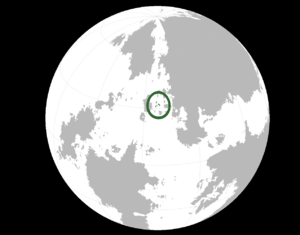Difference between revisions of "Archive:Sialia"
| Line 119: | Line 119: | ||
==Etymology== | ==Etymology== | ||
The native name, | The native name, ''Sjáliâ'' is a contraction of the noun ''sjál'' (meaning garden), and the country suffix ''-iljâ''. Thus, in ancient times, the country would have been known as ''Sjáliljâ'' (lit. country of gardens). | ||
==History== | ==History== | ||
Revision as of 12:39, 30 May 2016
| The Confederation of Sialan Emirates Njanêj Sjálâfý Falâjýfua |
||||
|---|---|---|---|---|
|
||||
| Motto: "" | ||||
| Anthem: '' Royal anthem: '' |
||||
| [[File:|center|250px|alt=The Locaton of Sialia on Sahar|The Locaton of Sialia on Sahar]] The Location of Sialia on Sahar
|
||||
| Largest city | capital | |||
| Official languages | Sialan | |||
| Demonym | Sialan | |||
| Government | Federal semi-presidential constitutional oligarchy | |||
| - | Premier | |||
| - | Seconder | |||
| Legislature | Assembly | |||
| - | Upper house | Emirate Council and Board of Islands | ||
| - | Lower house | National Assembly | ||
| GDP (PPP) | 2015 estimate | |||
| - | Total | 51246 | ||
| HDI (2015) | 0.945(GNII = 0.992; EPI = 0.942; LEI = 0.900) very high |
|||
| Currency | Sialan Sênam (SLS) | |||
| Time zone | WŠT (SCT-1) | |||
| - | Summer (DST) | SCT (CŠT) (SCT+0) | ||
| Antipodes | Marine, Asura Ocean | |||
| Date format | dd.mm.yyyy | |||
| Drives on the | left | |||
| Calling code | +290 | |||
| Internet TLD | .si | |||
Sialia (IPA: /siʲɑ:liʲə/, Native language: Sjálâ, IPA: /sʲa:liʲ'a/), officially The Confederation of Sialan Emirates, is a country located due West of Laefevia, in the Dragon Sea, near the Šarkunen peninsula.
Etymology
The native name, Sjáliâ is a contraction of the noun sjál (meaning garden), and the country suffix -iljâ. Thus, in ancient times, the country would have been known as Sjáliljâ (lit. country of gardens).
History
Geography
Geology
Sialia is dominated by its volcanology. Formed by a series of shield volcanoes, it is composed of mainly basaltic rocks which give its cliffs a distinctive black colour. Some areas are still volcanically active, leading to the use of geothermal power in the magmatic fissures (see Energy, below).
Climate
Sialia’s climate varies with wind direction. It has an average temperature range of 10-35°C, with 725-974 mm/yr of rain. If the wind blows from the north or south, the climate is noticeably wetter due to winds over the sea. From east or west, Sialia is sheltered from the worst of the weather, creating a drier climate during the summer.
Biodiversity
Politics
Government
Administrative divisions
Foreign relations
Military
Economy
Imports
Exports
Aside from fishing and tourism (the five volcanoes which make up the islands are incredibly popular with holidaymakers), Sialia’s main export is the Sialian Turkey Crab. The crab tastes of something you have just scraped off your boot and even with proper cooking has the texture of a car tyre, however it is only found off the cliffs of one of the islands and so is incredibly rare, making it a global delicacy and so highly sought after. It was almost fished to extinction in the 1800s, however highly strict rules have since been put in place to protect it and numbers have bounced back.
Transport
Energy
Sialia has pledged completely carbon-neutral in its energy production by 2020, thus creating all of its power from geothermal and wave energy.
Science and technology
Tourism
Demographics
Ethnic groups
Urbanisation
Language
Education
Healthcare
Religion
Culture
Heritage
Architecture
Much of the architecture on Sialia is white plaster walls with shallow terracotta roofs, although domes or flat roofs are not uncommon. The traditional form is that of a half-sunken basement forming the ground floor, to shelter from the sun. The windows themselves are heavily shuttered to protect against the midday sun and the storms which occasionally blow in from the south. Balconies are prevalent on top of an extended section of basement, creating a decking raised just above the ground. Entrances are half lowered into the ground, level with the basement, with thin slit windows placed horizontally across this basement to look out across the ground. Often the houses will have a small tower to catch the wind which blows across the islands in the Earthly Middle-Eastern style of a wind tower, to cool the houses and sometimes create extra living space, although the main body of the house is usually a two-storey dwelling.

